I know many of my readers have a close connection with Yosemite, so I thought you would want to know about some proposed changes to El Capitan Meadow. In most of the proposed alternatives for the park service’s Merced River Draft Management plan, fencing and signs would be installed to keep visitors from trampling the meadow.
John Sexton wrote a thoughtful post on Facebook about this issue, which I recommend reading. El Capitan Meadow has long been a favorite spot for photographers in Yosemite. Ansel Adams made his Oak Tree, Snowstorm photograph from there. Galen Rowell captured one of his most famous images, Clearing Storm Over El Capitan, from this meadow. John posted one of his wonderful photographs on his Facebook post. El Capitan Meadow is certainly a favorite place of mine too, and I’ve made many images there, including all the ones included here.
I know that the park service has a difficult job. They have to balance preservation with public use and enjoyment of the parks. Meadows are fragile, and are easily damaged by too much foot traffic, and the easiest way to prevent that damage is to fence off the meadow.
On the other hand, what makes Yosemite Valley so wonderful, so extraordinary, is the juxtaposition of soaring cliffs with the serenity of the meadows and meandering river on the valley floor. There are other places with magnificent cliffs. There is no other place with an idyllic valley surrounded by such high walls. The quintessential Yosemite experience is to wander out into a meadow, stare up at the cliffs and waterfalls, and soak up the tranquility. I would hate to see that experience taken away. There has to be a better solution than fencing and “Keep Out” signs for the valley’s meadows.
John has a good suggestion for El Capitan Meadow: to move the parking further away. One of the reasons this meadow gets so much foot traffic is that there’s a parking strip along the road for the entire length of the meadow. Removing this parking and making people walk, even a short distance, would greatly decrease the foot traffic, without installing unsightly and restrictive fences.
The comment period for the Merced River Draft Management plan ends Thursday, so there’s still time to make your voice heard. You can submit your comments here.
— Michael Frye

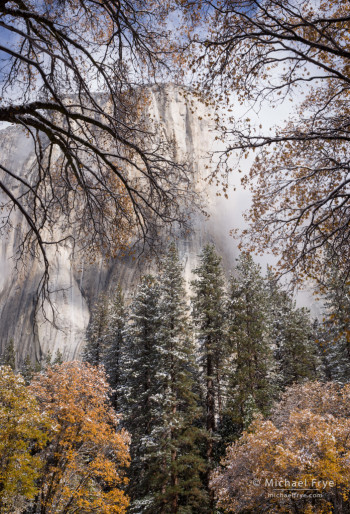

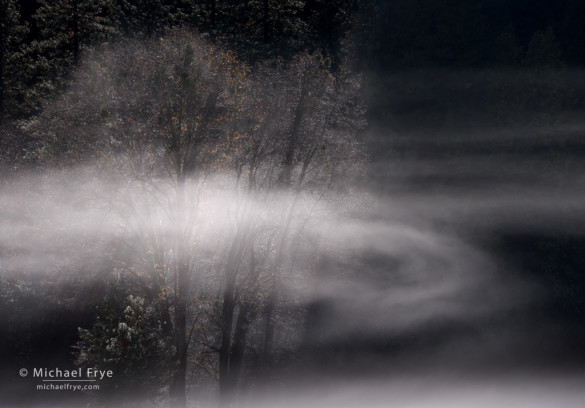
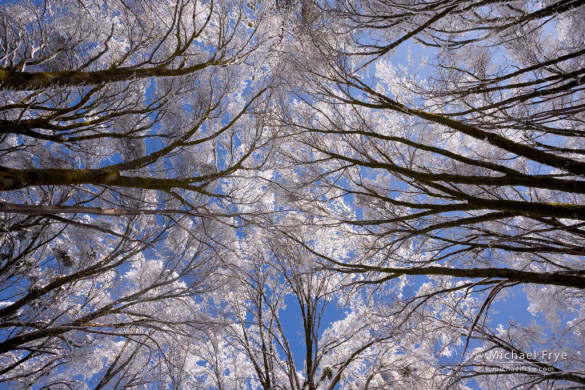
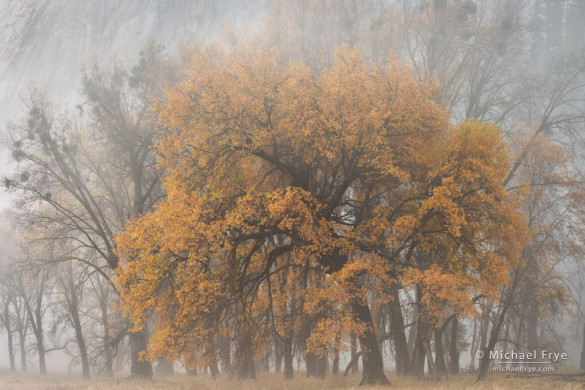
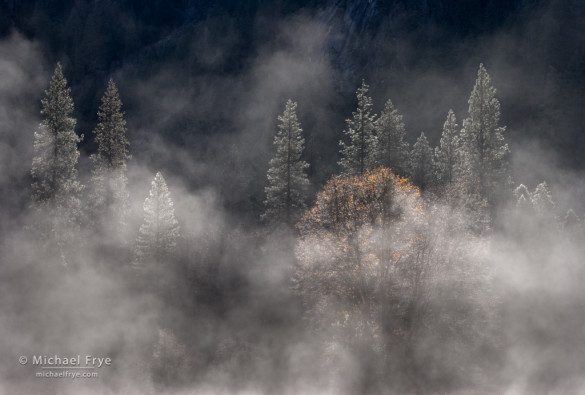








After yesterday’s news and I’m watching interviews from Boston now on Couric, seeing these images of yours are great for the soul. No exaggeration.
I’ll do something in those comment areas. I get so upset with elitists (that includes John Muir and Ansel Adams) who decry the onslaught of mere mortals who also want to enjoy that beauty. Why stop at the meadow? Why not stop people from HIKING and ruining the natural grass on the hills?
There is an air of only the ‘true’ inhalers of wilderness should be allowed access. In the meadow I did see the signs and followed only the parts that had already been pressed down, and believe me, while that is not pristine or pure or authentic, there are ways to control the downsides, and there is the pure beauty to be felt by others than the purists.
No bicycles? No boats? No horses? No, mere humans should not be allowed either, or at least keep them to a minimum.
What do we know about what is good and beautiful. We’re only ruiners. Cut lodging (they did try – proposing to remove half of Yosemite Lodging).
Remove the bridges? So it could be a small circle of beings’ play place and paradise? for only the initiated who can walk over rocks easily and to hell with the people who no longer can at older ages access some rarer areas.
Keep them from the meadows too — hey, a neat way is to make them park far away so they can’t get to it the way we can.
That’s all I’ll say here, but it’s a sore subject for me.
Andrys, obviously it is a sore subject for you. Adams and Muir are heroes of mine, and I don’t think they were elitists. Ansel certainly wasn’t — he loved the Ahwahnee Hotel, and was the founder of the Bracebridge Dinner there, as well as owner of a photography studio in the valley. He wasn’t someone who thought that Yosemite Valley should be returned to a pristine state. And without Muir we wouldn’t be having this discussion, or at least not the same discussion, as Yosemite wouldn’t have become a national park. Remember that he was talking to a world that, at the time, didn’t have any concept of conservation, and thought that every place should be open to extraction and development.
Oh I love both Muir’s writings and Adams’ photographs. And have several books of each but I ran across paragraphs by both in which they hoped for ways to limit access by tourists because of what that was likely to do TO what they loved about Yosemite.
I just got testy when reading those. And certainly when I read the summations of the SEVERAL current plans to cut lodging in half, take away the rights to bicycles, ride boats on the water, ride horses at all, remove BRIDGES that I love. All so it’d be as natural as if no people were around.
For me nature includes not only animals like bears but also animals known as people.
Hi Michael, thank you for your recent post (and great photographs!). I pasted Mr. Sexton’s post on Facebook (with a few of my own) on the comments section on the link you and he included above. I encourage all who read this to please do the same. Thank you again for your efforts and your great posts and photographs.
Thanks Tom for sending in your comments, and for sharing this issue with others. It’s good for the park service to get everyone’s input!
Michael,
Thank you for providing this information. I was following the MRP a while back, but not so much lately. Now, it’s much farther along in the planning. There’s several dozens pdfs, sections, etc., Can you point is in the direction of the part of the plan that talks specifically about El Cap Meadow? Or is it with all meadows? I’d like to read this myself, without reading the entire plan… before commenting or passing judgment on the plan 😉 Thanks!
ok, couldn’t wait and curiosity got me to look these up. For more info on the plan and specifically the 5 proposed alternative plans, check out Vol 1, Chapter 8 (4 downloadable sections, anywhere from 52-132 pages..) These describe the all the options. Note, Alt #5 is the preferred option. Check ’em out: http://parkplanning.nps.gov/document.cfm?parkID=347&projectID=18982&documentID=50778
Lon, glad you found it, and thanks for posting the link. It is, indeed, a lot of stuff to wade through!
Hi Michael, it really is a dilemma for the park service and all those ( me included ) who wish to see the park preserved and be healthy for generations to come. Besides photography, so many people love the experience of the meadow for so many reasons, it does not seem reasonable to now exclude this area. Maybe the parking idea will work or finding a way to limit certain areas as needed for regrowth. Closure and moving around the access areas is done in other sensitive areas, maybe with proper planning this could be done? In Joshua Tree there was some vandalism recently by way of painting of some rock faces. A sore subject to be sure, but it is so important to preserve our National treasures! I really hope the MRDM does the right thing and NOT cut off access, but come up with a reasonable solution. I will leave my comments as well.
Beautiful images by the way and thanks for the heads up.
Marc, I agree it is a dilemma. Such a tough balancing act. I’m glad you’ll be leaving your comments.
Thanks, Michael, for the update and inspiring photos.
Note also, that the comment period has been extended to April 30th, so there is still time to weigh in.
Now, hoping for the best while preparing for the worst, I will double my efforts to further refine my skills with the ‘clone stamp’ and ‘fill’ tools within Photoshop in anticipation of those unsightly fences and ‘Keep Out’ signs.
Chuck, thanks for pointing out that the comment period has been extended. I think that was announced shortly after I posted this. But there is no need for anyone to procrastinate if you want to make a comment! 🙂
All of Yosemite is a special place. I think I have read that John Muir called it a cathedral. Natures most holy shrine. As I walk the trails, visit the falls, just breathing the air, I feel the spiritual refreshment of Gods love for me, that He allowed me this moment to feel the power and beauty of his grand creation. I walk softly, quietly, and respectfully as I would in any man made cathedral. Even when I am home, working, paying bills, I stop from time to time and I can still hear Yosemite Falls, feel the mist upon my face, and I am healed.
I have walked the pathways of Yosemite from the early 1950’s, I have seen the changes. I remember the Fire Falls, the hotel at Glacier Point. I remember the campers in Yosemite valley being so numerous that their morning campfire smoke would cause the valley views to be choked with smoke and smog. After all these years the land of the campsites at the east end of the valley still have not healed.
The park today is a much better run park than it was 60 years ago. The large number of visitors who know nothing of respect for nature, as we did so many years ago, think the park as something to consume. And I suppose I am guilty too. It’s one think to say Ansel walked here and took this picture, I want to walk there too. But I am not the only one. You want to walk their too.
Next time I go to Yosemite I want to walk up to Old Inspiration Point and take a picture like Michael did. But I think when I get there, I will find 20 other Photographers who feel the same way, and we will all be adjusting our tripods for the sweet spot.
Maybe that is whats happening in El Cap’s meadow. Everyday their are 20 to 50 photographers trying to get just the right spot for their picture. Maybe one day their will be a concrete slab with little holes with a sign saying place tripod legs here. lol sad.
Thats just nature, we love it to death. Maybe the meadow needs to heal from to much love. Maybe we need to let it go for a season or two to let the grass and small trees grow back. And then in a few years we can go back and see it with new eyes again in awe and wonder.
This is a funny thought, but maybe you thought it too.
“I don’t want the meadow closed because I want to go there to take pictures, but I want it closed so nobody else can take pictures there. Just me, ok and maybe Michael too, and maybe all of you too. Oh, well. Take care
Thanks, You are all awesome.
Personally, I like the no parking idea as a way to limit impact without being too heavy handed.
It’s a tough balance. Too many people and the meadow becomes a flat, beaten, dusty plain. Too few people and no one learns to care. I don’t think it’s elitist to point out that what’s acceptable for a few people is a disaster for a multitude. But if something attractive becomes known, then the hordes arrive. But if no one knows about it, no one protects it.
I do think that the principle of “hardening” and sacrificing a few sites in order to minimize impact does work. In that sense the valley itself is the sacrifice to protect the rest of Yosemite. Sad, though.
Eric, interesting point about the valley being sacrificed to protect the rest of Yosemite. There’s some truth to that I think, though the valley is still a pretty great place.
Don’t get me wrong. The valley is almost a holy place to me, but it seems pretty clear that since most tourists cluster there that ‘hardening’ has some benefits. The Swiss do that pretty well, but they have a different relationship to nature than we do.
Like you I find the idea of getting rid of bike rentals rather nonsensical. After all, we *want* people out of their cars! Rafts… eh, I can’t see much loss in dropping them. The ice rink baffles me completely. It’s been there for a hundred years, all it involves is flooding a parking lot and it doesn’t hurt anything. Why stop it? There are some things in the new plan that make me wonder about the sanity of the drafters.
I hear you Eric. I haven’t been to Switzerland, but it would be interesting to see how they do it.
Thanks for bringing this to our attention. I hope a reasonable solution is found. Yosemite is a treasure we should all be able to enjoy without destroying it.
Don, I hope a reasonable solution is found too. It should be possible.
I’ve been reading through the summaries of all the alternative plans — boy there’s a lot of stuff here. Alternative 5 (the preferred plan) in combination with the “Common to All” plan seems very well thought out with many tough compromises made. Interestingly, the plan is to remove the roadside parking along Cook’s Meadow, but as you’ve mentioned, El Capitan Meadow gets a fence…. Seems like the roadside parking at El Cap could be removed to cut down on foot traffic with possible temporary fences in certain areas of the meadow to allow restoration. As I recall, there are a fair amount of informal trails in the meadow and I think fencing the entire thing off is a bit of a dramatic fix. The trails are there because you can park right next to the meadow anywhere you please. The comments I’m drafting for submittal will include this.
As a side note to those concerned about losing the commercial services, biking, rafting, and such will all still be allowed, but you’ll have to bring your own gear, much like other parks. I see no problem with this.
Aaron, I haven’t found the part about removing parking alongside Cook’s Meadow. I’ll look again. I’m okay with losing the rafting, but eliminating the bike rental doesn’t make sense to me. We want to encourage people to use bicycles rather than cars to get around the valley. Yes, people can bring their own bikes, but that’s not an option for someone flying to California and renting a car, plus not everyone owns bikes. Why make it more difficult for people to use bicycles when traffic and parking are such a problems?
That’s a good point about bike rentals. I’m not clear if they plan get rid of bike rentals altogether or just move where it takes place. I’ll have to look for it in the plan. The part about Cook’s Meadow is in the “Common to All” section — sadly, the page number escapes me at the moment.
In my area, Joshua Tree national park has recently closed or fenced off a number of popular places due to vandalism. While the meadows may not be vandalized, I can understand their desire to preserve it.
Maybe a resting period is the answer. Block it off for a while, then allow some traffic. Sounds a bit short sighted to put a parking lot right in front of the meadow and then back pedal and say too many people are trampling it.
In my mind, nature comes first and I would rather see regulated foot traffic in order to help preserve the beauty. No photograph is worth the loss of the natural beauty……if that were to happen then no photographs would be possible anyway.
Eric, I’m not sure how long the parking along the El Cap straightaway has been there, but it’s been awhile — at least since I first came to the park in 1980. So the trampling of the meadow (that might be overstating things a bit), has probably been a gradual thing, which the park service is now trying to address. There is lots of beauty in the meadow still, though maybe there would be more if there was less foot traffic. On the other hand, fences and boardwalks are also unsightly.
Most of the foot trails are in the east end of the meadow, where people stop and go into the meadow to look at climbers on El Capitan. Despite that, lots of wild irises bloom in that area after a wet winter. But maybe there would be more irises if there were fewer people walking around that area. The west end of the meadow is fairly pristine, with some thick patches of azaleas.
I think a resting period is a good idea. After the vegetation recovers, that in itself will be a barrier to foot traffic, as long as there’s not a long strip of parking right next to it. Nobody wants to walk through tall grasses and weeds. And maybe there’s a compromise where barriers and a boardwalk could be added to the east end, while parking is eliminated from the west end. So you’d have to walk to get to the west end, which would help keep it in its relatively pristine state. The plan isn’t specific about where the fences and barriers would be.
Actually I’ll amend that last sentence. The plan is pretty specific, and it sounds like there would be fencing along the entire length of the meadow:
1. El Capitan Meadow Area
• Restoration of Informal Trails: Remove all informal trails from the meadow that incise, promote habitat fragmentation, or are located in sensitive and frequently inundated areas, and restore to natural condition. Use restoration fencing along northern perimeter of meadow and designate appropriate access points using boardwalks and viewing platforms. Selectively remove mature conifers that block views of El Capitan from the roadside.
Having lived in Yosemite, and being a photographer, I feel that streamlining easy forms of entertainment is a great idea, ie taking out most of the “ease” out, aside from bike rentals! Yosemite is a natural splendor turned into a sort of lazy amusement park for a multitude… I also wish there weren’t all these motorized vehicles there. Frankly a tram or train of sorts as well as buses would be much more appropriate. We are not above Nature, we are of Nature, nothing elitist about that point of view.
Thanks for sharing your thoughts here Claire. I hope you’ll send them to the park service — the more voices heard the better.
The ‘ease’ has to do with people who can’t as easily do various walks as other, younger people can. Leave them out of accessing some of the most beautiful sites and we’ve lost a lot (especially with families hoping to share the beauties together and not just to capture beautiful shots in solitude), but not those who can ‘easily’ do it while others can’t will lose it.
“Frankly”? When I was there the first two times, I took the trams and buses EACH time and enjoyed them thoroughly. They already do have them. I later took them even on days when I had my car, beause I enjoy what I can see from being led around, time being short for most of us.
But I’d like to see Michael relegated to bus or tram travel to Tunnel View to be allowed to stand there and photograph with a multitude of others for 10 minutes each run of the tram.
I went back by car, as Michael often does from Mariposa. It’s not all just walking and hiking and taking more approriate mass transportation. Obviously they have to limit max access to the park at one time instead of just thinking of how much money they can make, but that won’t be easy to manage. But they should try.
I was there last, in May, loving seeing all the places that I could choose to go, yes, in my car, the way many photographers do, rather than carrying their tripods and other equipment on their bikes.
But on the Memorial Day weekend, cars could not move along the meadow we’ve been discussing. They had to have volunteer staff out there acting as traffic cops to move it *at all* and that situation does no one any favors. One does not see anything but other people’s elbows. But that’ll take a lot of thought and planning to regulate.
I still don’t understand the taking away of bike rentals (unless they’ve had problems I’ve not heard of, with people running into pedestrians the way it can happen at UC Berkeley’s campus). And removing the beautiful bridges?
I write as someone age 74, in relatively good shape for my age, and I get very put out by the talk of ‘lazy’ people. Glad I was able to enjoy the park the few times I have this past year. With the changes coming, they’re guaranteeing it will be harder to do so in the future except for the most capable.
And all of us would be affected by the ugly fencing in of that. Wow, nature, with fences surrounding it, like a museum exhibit of something that is no more.
It seems a relatively classic conundrum: Balancing the actions of the individual against the actions of the many. There are many things that we would regard as harmless at the individual level that we’d be appalled at if 100,000 people did the same. It’s the drawing of lines that’s difficult.
In Switzerland, I was impressed with the way in which the Swiss integrate paths and trails with railway and tram access, providing amenities in a few places and encouraging people to congregate there as opposed to the more difficult to access parts. The overall effect preserves much of the the natural feel while sustaining heavier use. But the Alps also have nothing we’d recognize as wilderness left. The Swiss are also a good deal more disciplined and orderly than Americans as well, who seem to regard it as our right to disregard regulations and to do as we please. Just watch the people ignoring the signs to clamber over the rocks at Lower Falls despite the danger.
I don’t have an answer. I think it’s unrealistic to try and return the Valley to some pre-human state. The park service is conducting selective burns to try and reopen the meadows that were there 150 years ago — meadows that only existed because the Native American residents set regular fires. I know there are those that would prefer to pull all development — the Village, the campgrounds, Curry, the lodge, the Ahwahnee — out of the valley and rip up the roads, turning it into a walk-in only site. In fact, that was the goal of the original 1978 plan. I don’t think that’s either reasonable or desirable.
I suspect there are just going to be a long string of hard choices.
But before they tear down the historic bridges I think they should tear O’Shaugnessey Dam down first! When they do that, I’ll listen to arguments about stone bridges.
Hi Michael –
Wonderful piece – I hope you don’t mind that I’ve linked over to your words in my blog. Thanks for what you’ve done in educating people about this.
I hope to see you in El Cap meadow sometime soon.
Here’s the short link through my wordpress blog: http://wp.me/p1vXSt-xJ
Thanks,
Lech
Of course I don’t mind Lech — thanks!